
The extent and severity of grub damage can vary from minor to severe. There are several factors that influence damage, but as a general rule it is most severe when infestation levels are high.
The damaging life stage of the white grub is during the larvae stage when it feeds aggressively on the roots of the grass. Knowing when and what to look for is important in order to identify damage or help prevent it from happening.
Repairing damage from white grubs is something nobody wants or likes to do. Depending on the extent of the damage, repair can be very costly and time consuming. Because the grubs feed on the roots of the turf, full recovery doesn’t always happen even when the damage is minor. Major damage caused by heavy grub infestations or from animals digging will require extensive renovation and lawn repairs.
It's officially summer, folks! While summer should be about relaxing and spending time outdoors with family and friends, it can often turn into a season of work if grubs are present in your lawn. Read on to learn about white grub damage and our suggested repairs.
Visual Turf Damage
Damage caused by white grubs can initially resemble drought stress which confuses many homeowners that don’t suspect grubs. As the grubs continue to feed and destroy the root system, these areas begin to wilt and turn brown. Turf that has been severely damaged no longer has a root system and can be easily lifted away from the soil as there is no longer roots to anchor it. This makes it especially easy for animals to pull back, rip and tear sections of the lawn away
Animal Damage

Damage as a result of raccoons, skunks and birds can often be the first sign to a homeowner that something isn’t right and white grubs may be present. Animal damage can be much more extensive than that caused by grubs. The animals dig away ripping turf back to get at grubs for a food source. Animal damage can be very frustrating as it is difficult to prevent from happening day after day.
Minor Repair Options
Major lawn damage isn’t always the result when grub infestations are present. Small isolated areas could have minor injuries requiring nothing more than a little extra TLC. Other areas showing signs of damage don’t always necessarily warrant major renovation and can be remedied with simple hand seeding.
- Watering: Monitor areas with stress closely. Minimizing stress to areas experiencing minor grub damage by maintaining adequate soil moisture is recommended. This will help keep the plant strong and able to resist minor infestations.
- Handseeding: Small areas no larger than the size of your hand can be spot seeded. This involves no equipment, just your hand to scoop seed out of a bag and sprinkle over these small areas. Best results can be achieved when the bare surface is scratched prior to seeding so the soil is broken up and seed to soil contact is optimal. A light layer of high quality soil can also be used to cover the seeded area to enhance germination.

Major Repair Options
When major repair is required, raking up and removing the dead and damaged grass is recommended. This leaves the soil bare and ready for renovation in these areas.
- New Sod: Installing new sod is the most expensive repair option for major damage. New sod replaces the damage instantly without having to wait weeks or months for new seed to establish. Unfortunately, animals that have had success digging for grubs seem to have good memories. It is not uncommon for animals to return to the same areas where they once feasted on grubs. The new sod may require staples to anchor it down until it establishes itself.
- Slitseeding: Slitseeding is an aggressive seeding option that requires a special machine to slice rows into the soil and drop seed directly into the slits. This provides excellent seed to soil contact and optimizes germination and establishment. Although this process takes much longer than installing new sod it is a very effective and the cost is substantially less than sod.
- Topdressing/Broadcast Overseeding: Broadcast overseeding combined with topdressing is another effective repair option. Covering the grass seed with topdressing helps protect the seed and enhance germination and establishment. This option is cost effective and provides great results.








